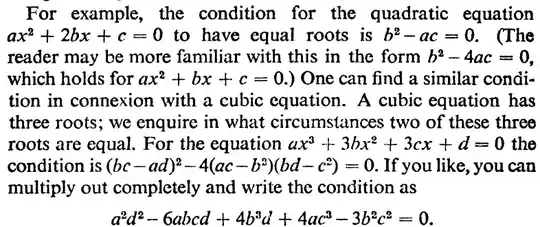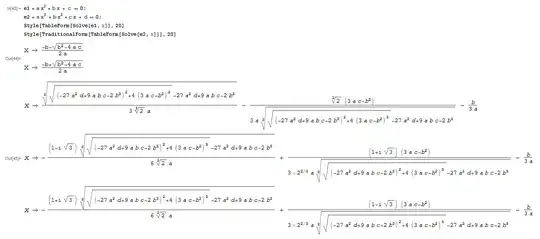Any cubic polynomial with roots $r$, $s$, $t$ has the form
$$k(x-r)(x-s)(x-t) = k x^3 - k x^2 ( r + s + t ) + k x ( r s + s t + t r ) - k r s t$$
for some $k \ne 0$. If we're taking that polynomial to be $a x^3 + 3 b x^2 + 3 c x + d$, then certainly $a=k$ so we won't bother using "$k$" further; also, by equating the remaining coefficients,
$$3 b = - a (r+s+t) \qquad 3 c = a (rs+st+tr) \qquad d = -a rst$$
If the cubic two equal roots ---say $s=t$--- then
$$3 b = - a (r+2s) \qquad 3 c = a s(2r+s) \qquad d = -a rs^2$$
Now, consider "the condition" that Sawyer proposes:
$$(bc-ad)^2-4(ac-b^2)(bd-c^2)=0$$
If you'd be satisfied knowing that the condition does what Sawyer claims, then you can simply apply it to our $a$, $b$, $c$, $d$ and what what happens. Note
$$\begin{align}
bc-ad &= -\frac{1}{9}a^2s(r+2s)(2r+s)+a^2rs^2 = -\frac{2}{9}a^2s\left(r-s\right)^2 \\
ac-b^2 &= \frac{1}{3}a^2s(2r+s)-\frac{1}{9}a^2(r+2s)^2 = -\frac{1}{9}a^2\left(r-s\right)^2 \\
bd-c^2 &= \frac{1}{3} a^2rs^2(r+2s)-\frac{1}{9}a^2s^2(2r+s)^2 = -\frac{1}{9}a^2s^2\left(r-s\right)^2
\end{align}$$
so that
$$(bc-ad)^2-4(ac-b^2)(bd-c^2) = \frac{4}{81} a^4 s^2\left(r-s\right)^4-\frac{4}{81} a^4 s^2\left(r-s\right)^4 = 0$$
That is, the condition is a somewhat magical relation that combines the coefficients ---which depend on $r$ and $s$--- in just the right way to make everything vanish. That, at least, explains the purpose of the condition; the derivation of the condition, on the other hand, is something of a mess. The powerful concepts of discriminant and (my favorite tool) resultant give high-level views that nicely blur the details, but if you aren't familiar with those ---or just want to try brute force--- how might you proceed?
Well, you can view the expressions for $a$, $b$, $c$, $d$ as a system of three equations in just two parameters $r$ and $s$. Because the system is over-determined, the coefficients cannot be free agents; they must be related somehow. Eliminating $r$ and $s$ from the system is the way to find the relation.
For starters, note that the last equation tells us that $r = -d/a/s^2$; substituting into the first two equations gives:
$$3 b s^2 = d-2as^3 \qquad 3 c s = -2 d + as^3$$
And then all we have to do is eliminate $s$ ... which gets back to the mess I mentioned. I'd normally invoke the method of resultants (with the aid of Mathematica), which automates the required clever algebra, but that's as unmotivating as pulling the discriminant out of the air. For now, I'll leave this as a challenge, and will update this answer once can bring myself to TeX-up the steps.
Okay, here's an elementary (though long and drawn-out) way to eliminate $s$.
Note: The point of this is that it's complicated; it makes you appreciate the machinery of the discriminant and resultant!
Combining the $3bs^2$ equation with twice the $3cs$ equation yields $3bs^2+6cs=-3d$ ... or, better,
$$bs^2=-(d+2cs)$$
The best way to think of this equation is that it allows us to re-write second-powers of $s$ in terms of first-powers of $s$, thus reducing an expression's $s$-degree in exchange for increasing its overall size. (In effect, we reduce expressions modulo the polynomial $bs^2+2cs+d$ ... curiously enough, a quadratic with discriminant $4(c^2-bd)$.) So, for instance, returning to the $3cs$ equation, we can multiply-through by $b$ a couple of times, ratcheting the $s$-degree down from $3$ to $1$ by replacing $bs^2$ where it appears ...
$$\begin{align}
3cs=-2d+as\cdot s^2 &\implies 3bcs = -2bd + as \cdot b s^2 \\
&\implies 3bcs = -2bd - as (d+2cs) \\
&\implies 3bcs = - 2 b d - a d s - 2 a c \cdot s^2 \\
&\implies 3b^2cs = - 2 b^2 d - a b d s + 2 a c (d+2cs) \\
&\implies s(3b^2c+abd-4ac^2) = 2d(ac-b^2)
\end{align}$$
We've just effectively solved for $s$, although I don't want to divide by its possibly-zero multiplier, which I'll abbreviate $m$ so that
$$s m = 2 d(ac-b^2)$$
Going back to the $bs^2$ equation and multiplying-through by $m$ a time or two ...
$$\begin{align}
b s^2 = - d - 2 c \cdot s &\implies b s^2 m = - d m - 4 c d (ac-b^2) = bd(bc-ad) \\
&\implies b \cdot s^2 m^2 = bd(bc-ad)m \\
&\implies 4 b d^2 ( b^2 - a c )^2 = bd(bc-ad)m \\
\end{align}$$
From the last equation, we get
$$b^2 d \left( a^2 d^2 - 6 a b c d + 4 b^3 d + 4 a c^3 - 3 b^3 c^2 \right) = 0$$
Ignoring the cases $b=0$ and $d=0$ in general, we find that "the condition" must hold when two roots of a cubic coincide! whew!
(In fact, the cases $b=0$ ---in which $r=-2s$--- and $d=0$ ---in which either $r=0$ or $s=0$--- fall under the umbrella of the condition.)

